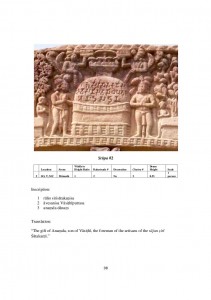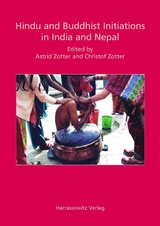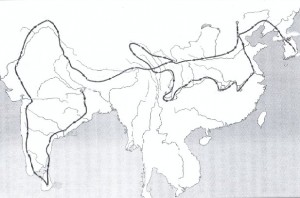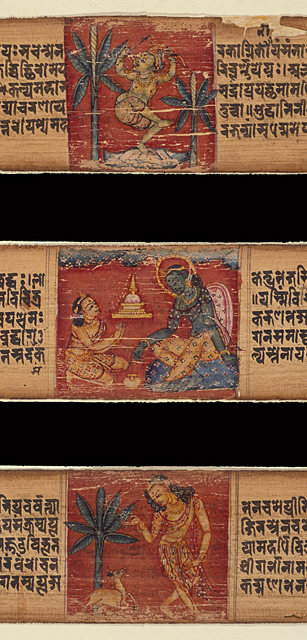Milligan, Matthew David. ‘A Study of Inscribed Reliefs within the Context of Donative Inscriptions at Sanchi’. M. A. thesis, University of Texas at Austin, 2010. [official site URI / PDF]
From the abstract

Milligan, Matthew David. ‘A Study of Inscribed Reliefs within the Context of Donative Inscriptions at Sanchi’. M. A. thesis, University of Texas at Austin, 2010. [official site URI / PDF]

Hisataka Ishida. „Dharmottaras Pramāṇaviniścayaṭīkā zum auf der Realität basierenden logischen Nexus“. Ph. D. Dissertation, Philologisch-Kulturwissenschaftliche Fakultät, Universität Wien, 2011. [official site / PDF]
Vienna is producing dissertations on the pramāṇa manuscripts in China at an impressive rate. I note, however, that projects which might have been expected to showcase the cultural achievements of Tibet do not always turn out that way:
Since the manuscript is a codex unicus, a diplomatic edition is also included, as is an edition of the Tibetan translation. The [necessity of including the] latter is due to the fact that, upon closer examination, it became apparent that the Tibetan translation shows frequent “deviations”, likely due to the free translation style of the Tibetan translator monk rNgog Lotsaba. These deviations cannot be briefly stated in the critical apparatus of the Sanskrit edition in a manner that would be meaningful for the reader, and thus this edition has been added.
Roger Wright. ‘The Guhyasamāja Piṇḍikṛta-sādhana and its context’. MA thesis (Religions), School of Oriental and African Studies, 2010. [PDF (‘internet version’)]
This paper analyses and comments on the Piṇḍikṛta-sādhana, a ritual practice manual for the Guhyasamāja Highest Yoga Tantra, attributed to Nāgārjuna. It is based on a correlated translation of the Sanskrit and Tibetan versions of the text prepared for the purpose. […]
Particular attention has been given to making the translation of the visualizations of the architecture and the deities themselves clear by providing tables and illustrations. The philosophical background of the text is investigated and the way in which that was subtly altered by subsequent commentators when it no longer fitted the later “philosophical climate” is made clear. The continuity of the practice is discussed, from its inception to the present day.
Mori, Masahide. Indo mikkyō no girei sekai (The Rituals of Tantric Buddhism in India). Sekai Shisōsha, 2011, 340pp. ISBN 978-4-7907-1498-9. [official site / amazon.co.jp]
森 雅秀〮著 『インド密教の儀礼世界』 世界思想社 7140円
“The iconology of tantric Buddhist ritual.
[This book] makes the full picture of tantric Buddhist ritual emerge through elucidation of the structure and semiology of ritual in Indian tantric Buddhism. Its illumination of [a previously] unknown ritual world, Buddhist studies and Indology, as well as religious studies, anthropology, history, archaeology and art history and so on will have a wide impact on several areas.” [translated blurb]

The contributors to this volume are from different academic disciplines and treat examples of both kinds of rituals in various religious settings. Of special interest in this collection of essays are interrelationships among initiations and their relations to other kinds of rituals. The papers are devoted to the study of minute details and point to the dynamics of initiations. The transfer of ritual elements accompanied by readjustments to new contexts as the modification of procedures or the reassignment of meanings is one of the recurring traits. Other aspects addressed by the authors include the relation of script (ritual handbooks) to performance or various forces of change (e.g. the economics of ritual, gender-related variations, modernization and democratization). Continue reading “Zotter & Zotter, ‘Initiations in India & Nepal’ (2010)”
C. Pierce Salguero. Buddhist Medicine in Medieval China: Disease, Healing, and the Body in Crosscultural Translation (Second to Eighth Centuries C.E.). PhD diss., Johns Hopkins University, March 2010. 395 pp. [abstract at author’s site/PDF]
Abstract
This dissertation is a study of the role of literary and cultural translation in the transmission and reception of Buddhist medicine in medieval China between the second and eighth centuries. This dissertation brings to light the diversity of medical material in the Chinese Tripitaka, analyzes the central metaphors and discourses in this corpus, and examines how these foreign medical ideas were understood in their historical context. I employ methodologies from Translation Studies to reconcile the study of the transregional exchange of linguistic and cultural repertoires with the agency of individual historical authors as they retooled and adapted foreign knowledge to forward contemporary social strategies. I utilize this theoretical framework to analyze how Indian medical doctrines influenced Chinese Buddhist discourses and practices, while also emphasizing the importance of disease, healing, and the body as sites of crosscultural negotiation.
[via kuden-ML]
David V. Fiordalis. Miracles and Superhuman Powers in South Asian Buddhist Literature. PhD diss., University of Michigan, 2008. 232 pp. [HDL / PDF]
Scholars have long been aware of the presence of marvelous events in Buddhist literature. While it is now more fashionable to speak about them, some still hesitate to use the word miracle in reference to Buddhism. Paying attention to how Buddhists defined their own terms, this dissertation argues that the concept of the miracle is appropriate to use in translating specific Buddhist terminology. The present study examines the narrative and scholastic language Buddhists used to denote and classify various types of miracles and superhuman powers. […] Continue reading “Fiordalis, ‘Miracles in South Asian Buddhist Lit’ (2008)”
Ronald James Dziwenka. ‘The Last Light of Indian Buddhism’ — The Monk Zhikong in 14th Century China and Korea. PhD diss., University of Arizona, 2010. 406 pp. UMI Number: 3412160. [Thanks to A. M.]

Märt Läänemets. ‘Gaṇḍavyūha-sūtra kui ajalooallikas (The Gaṇḍavyūha-sūtra as a Historical Source)’. Dissertationes Historiae Universitatis Tartuensis 17. PhD diss., Tartu University, 2009. 281 pp. [abstract / PDF]

Allow me to briefly take up a couple of points mentioned in the summary. Firstly, it is surprising that the writer concludes that the Gv was composed in Central Asia “on the basis of extra-textual historical facts”, even though it is pointed out that the action takes place almost entirely in identifiable sites in South India (p.269).
Secondly, it is stated that the “Gv reached Nepal… no later than the middle of the 12th century, but likely a century or two earlier” (p.268). Here Läänemets refers to an MS dated ~1166 CE, which he describes as the oldest and “only [this must be a typo] extant text”. There is no reason to think that the Gv was not circulating in Nepal in approximately the same period that it began to circulate in the rest of South Asia, even if very few palmleaf MSS have survived. For instance, Kamalaśīla, who prescribes the recitation of the Bhadracārī (which was attached to the Gv by Kamalaśīla’s time, the late eighth century) as part of a bodhisattva’s routine in his first Bhāvanākrama, is said to have resided in Nepal, where such texts were presumably already well known.
One Nepalese MS which is not mentioned is an illustrated palmleaf codex, preserved in just a few folios across two collections in the United States: at LACMA [see right; link], and Brooklyn Museum [link]. Although the folios at LACMA have been studied by the inimitable Dr. Gautam V. Vajracharya, I do not know whether these two remarkable leaves have been identified as constitutents of the same codex, as they manifestly appear to be.
Mattia Salvini. ‘Convention and agency in the philosophies of the Mahāyāna.’ PhD diss., Dept. of Study of Religions, School of Oriental and African Studies, 2008. 369 pp. [worldcat]
The thesis focuses on the relationship between Sanskrit classical grammar, Abhidharma, and the debates between Madhyamaka and Yogācāra. In particular, it shows how the kāraka system, and the idea of lakṣaṇa, influence philosophical argumentation in the context of medieval Indian Buddhist thought. […] Continue reading “Salvini, ‘Convention and agency in Mahāyāna’ (2008)”